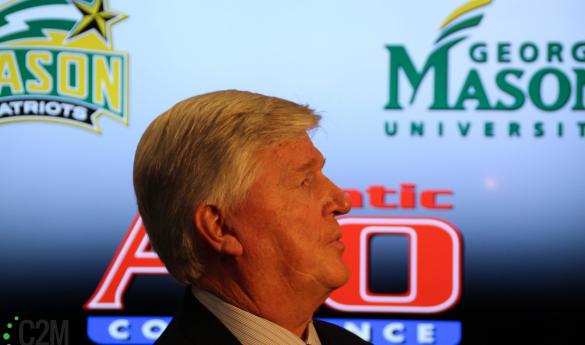Mason announces move to the Atlantic 10 for all sports effective July 1
George Mason University announced in a press conference today their decision to move to the Atlantic 10 conference for all sports, effective on July 1.
According to a Mason Athletics press release, the university’s decision to move to the A-10 will “help further showcase the exemplary contributions of Mason’s faculty and students and all that the university has to offer."
 |
| President Angel Cabrera and Tom O'Connor announce the move to the Atlantic 10 (photo by John Irwin). |
“Our partnership with the Atlantic 10 aligns with our core commitments as we move into the next phase of this university’s impressive journey,” said Mason president Ángel Cabrera via video conference.
Mason, a founding member of the Colonial Athletic Association in 1985, felt the time was right to relocate to the A-10 with uncertainty within the CAA and drastic conference realignment across the country.
"With changes in the collegiate landscape, the opportunity to become a member of the Atlantic 10 conference provides outstanding opportunities for our intercollegiate athletics program and the university as a whole,” said Mason athletic director Tom O’Connor. “Our vision to be the best overall athletics program in the conference, with an emphasis on men’s and women’s basketball, perfectly aligned with the Atlantic 10’s vision and accomplishments.”
With the addition of Mason, the A-10 brings in a 13th school to the conference, and another Virginia school that re-affirms rivalries between Mason, Virginia Commonwealth University and Richmond while allowing the so-called "Battle of the Orange Line" between Mason and George Washington University to be rekindled.
The A-10 has been particularly successful in men’s basketball recently, which was the main concern of Mason Athletics in the decision to join the conference. For the second year in a row, five schools received bids to the NCAA Tournament and each school advanced to the third round.
Butler, Xavier and Temple will all be leaving the conference on July 1, so adding Mason opens a new phase for the A-10 in finding successful academic and athletic institutions to fill the void.
Repercussions of the move for Mason include paying a $1 million exit fee, forfeiture of roughly $1.65 million in conference payouts and ineligibility of spring sports participation, including women’s lacrosse, baseball, softball, men’s and women’s track and rowing in the CAA conference championships in May.
O’Connor also mentioned in the press conference his remorse to the student-athletes and coaches for the lack of postseason play with the intent of holding an individual meeting with the senior student-athletes.
However, with the move to the A-10, student fees will not be increased to fund the endeavor.
“Every decision that we make, we look at it very, very carefully,” Cabrera said. “In assessing this move, we made sure that we could do it without imposing any additional burden on our students. That was a key part of this decision.”
According to estimates conducted by Mason administration, if the A-10 continues its athletic success in the coming years, it would be a positive move financially for the university.
“We’ve been analyzing this from different time frames,” Cabrera said. “In as little as five years, this becomes a very positive move for us if not sooner. We’re structuring things internally through internal loans so that in fact, the additional expected revenues will compensate for the investment. So, really no financial concerns at all.”

